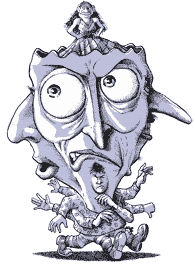Singin’ in the Rain is one of the few classic old musicals I adore. (I love musicals, but I prefer the modern stuff – I’m a sucker for anything Sondheim). I was watching it for the nth time the other day, when I noticed yet another example of how deeply weird this film is.
I’m not talking about the totally surreal “Gotta Dance” sequence, which is the most striking example of weirdness (a film set in the fifties set within a film set in the 1700s in a film which is itself set in the 1920s). Nor am I pointing out that the famous “Singin’ in the Rain” dance sequence actually takes place in a downpour made of milk (showed up on the cameras better than water would have). No, I’m talking about an interesting way the script plays with the standard conventions of musicals.
In musicals, songs come in one of two types: First is the “hey, kids, let’s put on a show” song, in which the character performs a song. The second type is the “expression of what’s in my heart” song, in which the actor sings, but the character herself isn’t actually supposed to be literally singing.
In Singin’ in the Rain, for example, the title song isn’t something the main character (played by Gene Kelly) performs on stage; it’s a spontaneous expression of his heart, performed on a rainy street as he walks home.
Or is it?
Think of the ending: good-hearted-but-unknown actress Kathy Selden (played by a very cute Debbie Reynalds) is forced to sing hidden behind a curtain, so that evil-but-famous Lina Lamont (played by a wonderfully nasty Jean Hagen) can lip-synch to Kathy’s singing and thus pretend to have a wonderful singing voice. “What are you going to sing?” the bandleader asks. “What song?” Lina hisses to Kathy (hidden behind the curtain). “Singin’in the Rain,” Kathy whispers back. “Singin’in the Rain,” Lina tells the bandleader.
So the band starts playing “Singin’in the Rain” – clearly, they all know it – and Kathy sings it while Lina (who clearly knows the words and tune) lip-synchs. And I’m left going: Whaaaa?
Just a few scenes ago, this song was presented as if it were a spontaneous display of what’s in Don Lockwood’s (Gene Kelly’s) heart. Now, it’s suddenly an old standard – everyone knows it, Lila, Kathy, the bandleader, the entire band.
Just a nice bit of genre-play in an already wonderfully weird movie.
(Actually, this particular kind of genre play takes place twice in the movie; in the bit I describe above, and also during the “Good Morning” sequence)..



It is one of my favorites also. To me it gets
a lot of it’s cache by falling into the “movies
about movies” genre – which I am a sucker for.
There is just something about movies that let the
viewer in on the inside of movie making – being
obvious about the fact that you are watching a production rather than “reality”, that enhances
the experience for me as a viewer.
There are quite a few of these – “Day for Night”
comes to mind immediately – but Singing in the Rain
is the only musical I can think of.
The over the top “Moulin Rouge” comes close :)
I always read the Gene Kelly scene as the character singing the song – not the actor. And I think the key is the setting – alone at night – and the cop.
It’s not like some musicals where he’s walking down a busy street past people who behave like it is perfectly normal for some guy to be doing a big song and dance number out on the sidewalk. It’s late, it’s raining, no one is around and he’s a show-biz type and he breaks into what is (in the movie’s world) a current popular song.
This is affirmed by the cop who appears to be reacting to his singing and dancing as if this sort of behavior on a city street is not considered exactly normal.
The characters are all show bizness people so it seems natural that they might actually break out into song.
Maybe I’m just seeing it this way because I watched “Cotton Club” last night where all the music and dancing are done by the characters who seem to spend all their time – work and leisure – singing and dancing…thekeez
It’s not like some musicals where he’s walking down a busy street past people who behave like it is perfectly normal for some guy to be doing a big song and dance number out on the sidewalk.
I suspect that New Yorkers, used to their insane and to their aspiring actors, wouldn’t react much. But yes, Mr. Keez, you wrote my thoughts exactly.
Oh, is that all? Easy explanation. Move aside, folks, this is one of my areas of expertise. :) Seriously, it’s an unwritten rule of musicals taht any song that shows up as a spontaneous burst will inevitably be made into a standard “behind the scenes” later on. Think for a second: it was Don Lockwood’s idea in the first place to save the movie he and Lina were doing by making it into a musical. So he and Cosmo take care of writing the songs. And “Singing in the Rain” becomes one of those songs after Don realizes to himself (again, this doesn’t happen on camera), “hey, this thing that just came out of my heart is pretty good, let’s stick it in the movie Lina and I are doing!” The audience in the theatre knows it because they’ve just seen the movie-within-the-movie; all we’ve seen is the ending of “Would You” and the kiss.
Neat explanation, Elayne!
One question, though. You write: Seriously, it’s an unwritten rule of musicals taht any song that shows up as a spontaneous burst will inevitably be made into a standard “behind the scenes” later on.
What other musicals are examples of this? I can’t think of any offhand, but that may be because of which musicals I listen to.
It’s even more tangled than that, since Freed/Brown published “Singin’ in the Rain” in 1929, just two years after The Jazz Singer; it was performed in The Hollywood Revue of 1929. Ergo, Gene Kelly “spontaneously” sings a standard from the early days of film musicals in a film about the early days of film musicals–anticipating the song’s actual debut by about two years…
Several of the songs in Singin’ in the Rain are, in fact, old standards–including the title song, as Miriam pointed out.
I’ve always taken it to be Don Lockwood singing a song to himself because he’s happy. Happens to be a popular song that a lot of people know. I do this all the time; why shouldn’t he, just because he’s a character in a musical?
It’s a bit unconventional from the standpoint of the modern musical, but not half as outre’ as lots of things Busby Berkley did back in the thirties. If you want weirdness, go get “An American in Paris”.
The music therapist’s take (which may be similar to some posted above): Don Lockwood, who knows lots of songs, finds himself in love and in the rain — and an amazingly appropriate song comes to him, and he sings it. That’s enough, but you can also add an unshot scene in which he tells Kathy about his silly street dance and the song he was singing, which makes her choice of it at the end kind of a “up yours” to Don (when she thinks he’s betrayed her).
As far as that “convention” goes, the only one I can think of that qualifies is Oklahoma — at the end, as everyone drives off to see Curly and Laurie to the train, they’re singing “Oh What A Beautiful Morning,” which was Curly’s spontaneous song in the first scene.
There are several musicals in which the final scene has an off-screen chorus singing a song from the musical — I think musicals like “Easter Parade” and “Meet Me in St. Louis” end that way. In those, though, I think of the chorus as being the same as that full orchestra that’s always lurking behind the couch or under the table.
Does Christopher Plummer suddenly know the words to “The Sound of Music” at some point in that musical?
Add to the above explanation the fact that the audience at the time the movie was released knew the song; when Gene/Don starts singing it, it’s a familiar song to them. And audiences at the time (before the singer/songwriter) were more used to the idea that people express themselves in songs other people have written. Compare Spencer Tracy and Katherine Hepburn singing ‘Night and Day’ in Desk Set. Well, singing isn’t the best description.
Also, isn’t the next Don Lockwood movie, the one co-starring Kathy, called ‘Singin’ in the Rain’? My recollection is that the last shot of the film is of the billboard for that movie, but I haven’t seen it for a few years. If so, presumably that movie, too, features a new and wonderful version of Singin’, which we have never heard and never will…
Redintegro Iraq,
-V.